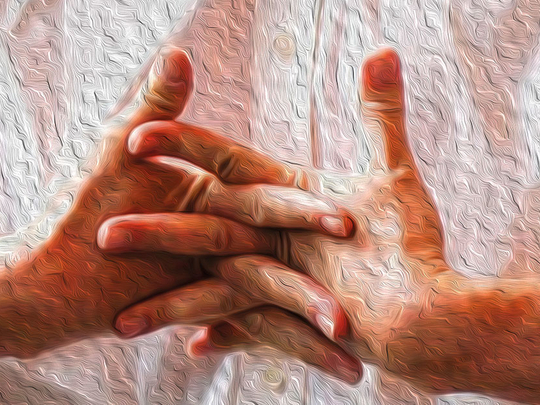
Washington: Are you a toe-tapper, hair-twirler, eye-blinker, head-nodder, nail-biter, knuckle-cracker, skin-picker, lip-licker, shoulder-shrugger or a chin-stroker?
Call it a nervous habit or tic, almost everybody has at least one — whether they are aware of it or not.
Tics exist on a spectrum ranging from barely noticeable to extremely annoying, to potentially injurious.
While research has focused mostly on the more severe forms associated with neurobehavioural disorders such as Tourette syndrome and autism, there’s a growing realisation of the pervasiveness of repetitive, non-functional motor behaviours and that the degree to which you engage in them is a barometer of your peace of mind. “Our stressful society definitely brings it out more,” Dr Alon Mogilner, a neurosurgeon at New York University Langone Medical Center, said. “It’s a delicate balance within the circuitry of the brain so you are able to tamp down on things you don’t want to do.”
Experts divide repetitive, non-functional motor behaviours into three overlapping, and not always agreed upon, categories. First, there are classic tics, which typically involve quick, jerky motions of the head, neck or arms preceded by an urge, akin to an itch that needs to be scratched. Tics can also be phonic such as throat-clearing.
Next are stereotypies, which usually don’t have a premonitory feeling and are more fluid and rhythmic such as body rocking and leg bobbing. Lastly, there are body focused repetitive behaviours, which are essentially grooming gone awry such as compulsive nail-biting, hair-pulling and skin-picking.
All of these behaviours are what experts call “unvoluntary”, as opposed to an involuntary muscle twitch. You can stop the tic when asked to or when distracted but the problem is, sooner or later, you go back to doing it.
“If we dive into the research and look at disordered, unwanted repetitive behaviours as well as nonclinical, nonimpairing repetitive behaviours, they all involve the region of the brain called the basal ganglia, which is involved in motor control,” said Ali Mattu, a clinical psychologist who specialises in body-focused repetitive behaviours at Columbia University Medical Center.
Animal instinct
Although still poorly understood, the basal ganglia are sort of like the movement command centre of the brain that responds to situations by choosing from a menu of motions or gestures that you’ve learned. The theory is that when situations are frustrating or stressful because you are either over- or under-stimulated, your basal ganglia manage by selecting (or perhaps failing to inhibit) a default motor behaviour, which would be the tic.
In this way, we are not so different from animals. Go to many zoos and you’ll see anxious or bored animals rocking, jerking their heads, plucking out their feathers, pacing in circles, swinging their arms and mouthing themselves or various objects. “The whole point of a habit is you don’t have to use cognitive resources to do it,” said Doug Woods, a professor of psychology at Marquette University in Milwaukee who studies and treats people with tics and other repetitive behaviours. He said that for many of his patients, the tics somehow become associated with a reward — whether it’s temporary distraction or release.
Most repetitive behaviours, regardless of etiology, begin in childhood. The immature brain, unable to recognise and process emotions as an adult does, resorts to motor activity to cope. Except for children with severe autism, most kids grow out of habits such as head-shaking and arm-flapping as they become better able to understand and manage their feelings. Or they just find a way to convert the behaviour into something more socially acceptable and “adult”. Rocking might morph into leg-bobbing or iPhone-fiddling, for instance.
“These behaviours persist, it’s just the person learns to have more control over it or learns to do it in private or under the table,” Dr Harvey Singer, professor of neurology at Johns Hopkins School of Medicine and specialist in childhood stereotypies, explained.
Most people don’t seek treatment and indeed, many find their repetitive behaviour comforting. Help is generally only sought when the movement or vocalisation becomes so insistent it impairs daily functioning or is a turn-off in relationships.
To help people stop, doctors first rule out drugs such as antihistamines and antidepressants or heroin as a cause or aggravating factor. Assuming this isn’t the case, treatment begins with raising the person’s awareness of the tic or motor habit since it’s become so automatic. This usually involves describing it to a therapist in detail including any urges that precede it and every aspect and nuance of the movement.
Also important is to look at when it’s happening.
“People don’t realise it, but there’s a situational profile to all these problems,” said Dr Kieron O’Connor, a professor of psychiatry at Institut Universitaire en Sante Mentale in Montreal, who develops treatment programmes for people with tic and motor habit disorders. “Tics and motor habits, people tend to do in some situations and not others so we work on helping patients to evaluate those problematic situations differently.”
The repetitive behaviour is often the result of situations that make people feel overwhelmed with emotion.
Use of drugs
In addition to the cognitive component, therapies often include a behavioural or habit -reversal component where a person finds a more acceptable competing or inhibitory action.
For more severe and debilitating cases, antipsychotic medication, botulinum toxin injections and implantation of a deep brain stimulation device might be considered, although all of those options are riskier, can have unpleasant side effects and are not entirely effective.
There’s growing consensus among experts that behaviour is a form of communication and it’s important to first understand what the tic or habit is telegraphing in order to help the person cope rather than just trying to stop, modify or provide a substitute behaviour.
—New York Times
News Service












